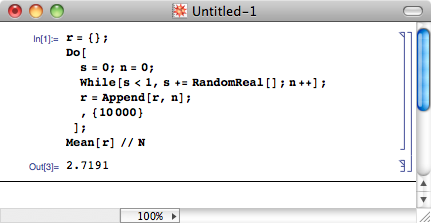依次考虑下面三个问题。
1. 一根单位长的木棒。随机在中间选取一点,把这根木棒折断。那么,短的那一截木棒平均有多长?
2. 一根单位长的木棒。随机在中间选取一点,把这根木棒折断。那么,长的那一截木棒平均有多长?
3. 一根单位长的木棒。随机在中间选取一点,把这根木棒折断。那么,短的那一截与长的那一截的长度之比平均是多少?
依次考虑下面三个问题。
1. 一根单位长的木棒。随机在中间选取一点,把这根木棒折断。那么,短的那一截木棒平均有多长?
2. 一根单位长的木棒。随机在中间选取一点,把这根木棒折断。那么,长的那一截木棒平均有多长?
3. 一根单位长的木棒。随机在中间选取一点,把这根木棒折断。那么,短的那一截与长的那一截的长度之比平均是多少?
最近看到几个有趣的数学谬证,想写下来与大家分享;结果写到这个又想到那个,一写就写个没完,于是想到干脆做一篇谬证大全,收集各种荒谬的证明。
如果你有什么更棒的“证明”,欢迎来信与我分享,我会更新到这篇日志中。我的邮箱是 matrix67 at tom.com ,或者 gs.matrix67 at gmail.com 。
1=2?史上最经典的“证明”
设 a = b ,则 a·b = a^2 ,等号两边同时减去 b^2 就有 a·b – b^2 = a^2 – b^2 。注意,这个等式的左边可以提出一个 b ,右边是一个平方差,于是有 b·(a – b) = (a + b)(a – b) 。约掉 (a – b) 有 b = a + b 。然而 a = b ,因此 b = b + b ,也即 b = 2b 。约掉 b ,得 1 = 2 。
这可能是有史以来最经典的谬证了。 Ted Chiang 在他的短篇科幻小说 Division by Zero 中写到:
There is a well-known “proof” that demonstrates that one equals two. It begins with some definitions: “Let a = 1; let b = 1.” It ends with the conclusion “a = 2a,” that is, one equals two. Hidden inconspicuously in the middle is a division by zero, and at that point the proof has stepped off the brink, making all rules null and void. Permitting division by zero allows one to prove not only that one and two are equal, but that any two numbers at all—real or imaginary, rational or irrational—are equal.
这个证明的问题所在想必大家都已经很清楚了:等号两边是不能同时除以 a – b 的,因为我们假设了 a = b ,也就是说 a – b 是等于 0 的。
考考你的立体几何直觉:用一系列间距相等的平行平面把一个球体切成厚度相同的薄片,这些薄片的侧面积都相等吗?

数学常数最令人着迷的就是,它们常常出现在一些看似与之毫不相干的场合中。 随便取一个 0 到 1 之间的数,再加上另一个 0 到 1 之间的随机数,然后再加上一个 0 到 1 之间的随机数⋯⋯直到和超过 1 为止。一个有趣的问题:平均需要加多少次,才能让和超过 1 呢?答案是 e 次。
